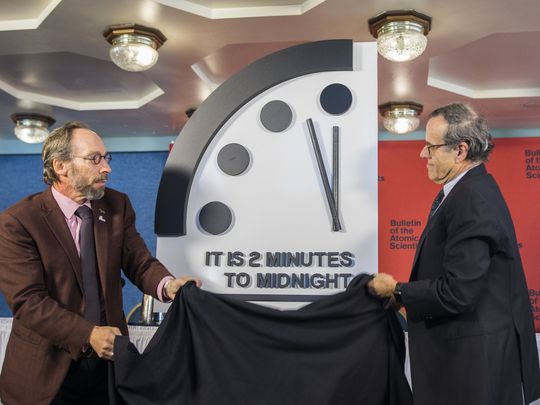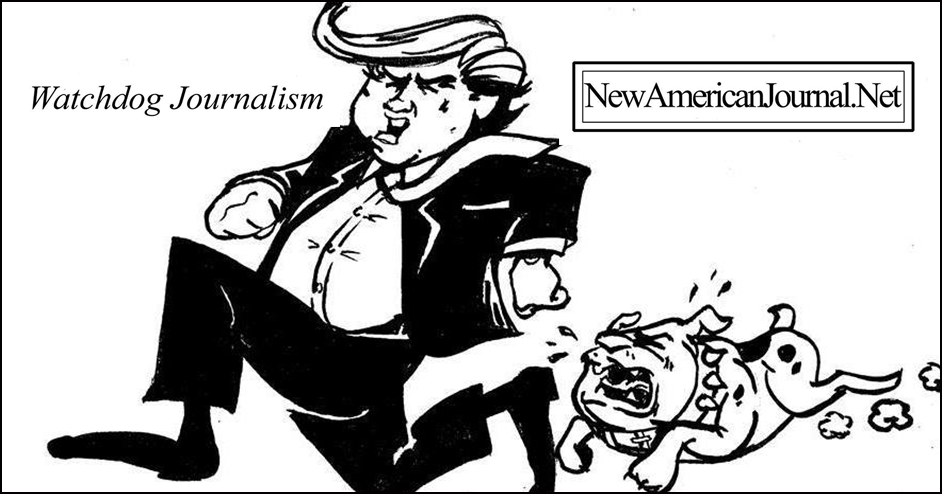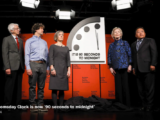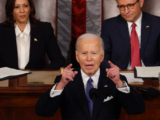By Glynn Wilson –
One day before U.S. President Donald J. Trump blinked and caved into demands by Democrats in Congress to reopen the federal government with no agreement on funding for his ill-conceived border wall, the Bulletin of the Atomic Scientists board met in Chicago and kept the hands on the Doomsday Clock set at two minutes before midnight, the moment of apocalypse for humans on planet Earth.
The clock hands had been moved into that position so close to the world-ending apocalypse in 2017 after Trump was sworn in as president vowing to pull out of the Paris accords on climate change, to retreat from a nuclear deal with Iran, escalating tensions with North Korea over its nuclear program, and Trump’s vow to gut science information, research and environmental regulations from the federal government during his pro-big business administration.
Citing a renewed nuclear arms race, lack of action on rising greenhouse gas emissions and climate change, and the emergence of state-sponsored disinformation campaigns, the scientists say humanity is as close to a “new abnormal” that could lead to global annihilation as the planet was at the height of the Cold War.
“It is still two minutes to midnight. Humanity now faces two simultaneous existential threats, either of which would be cause for extreme concern and immediate attention. These major threats — nuclear weapons and climate change — were exacerbated this past year by the increased use of information warfare to undermine democracy around the world, amplifying risk from these and other threats and putting the future of civilization in extraordinary danger,” the new report concludes. “The ‘new abnormal’ that we describe, and that the world now inhabits, is unsustainable and extremely dangerous.”
The last time the clock hands were this close to midnight was in 1953, when the U.S.-Soviet arms race escalated as Moscow tested a hydrogen bomb in August after the detonation of an American H-bomb the previous November.
“In many forums, including particularly social media, nationalist leaders and their surrogates lied shamelessly, insisting that their lies were truth, and the truth ‘fake news,’” the report says.
Fears of an apocalypse, an event involving destruction or damage on an awesome or catastrophic scale for the Earth and humanity, have been around since the 1940s, since the U.S. dropped two nuclear bombs on Japan to end World War II. Some religious groups see an apocalypse as the complete and final destruction of the world, as described in the biblical book of Revelation.
Despite a softening of barbed rhetoric between Trump and North Korean leader Kim Jong Un over the past year, the scientists still see rising threats in nuclear-armed nations with nuclear modernization programs, what it calls “a worldwide arms race.” Trump has even blatantly threatened to escalate this into space with his so-called “Space Force.”
On climate change due to global warming from the burning of fossil fuels for energy, the group says carbon dioxide emissions resumed an upward climb in the past two years since the Trump administration reversed course from beginning to tackle the issues on the part of the Obama administration.
To turn back the clock, the scientists recommend steps to fortify and extending U.S.-Russian nuclear treaties with limits on modernization programs, adopting safeguards to prevent peacetime military incidents along the borders of NATO countries, and urges citizens to become more involved than ever in demanding action on climate change and multilateral talks to discourage the misuse of information technology.
“The world security situation can be improved, if leaders seek change and citizens demand it,” the scientists say. “It is 2 minutes to midnight, but there is no reason the Doomsday Clock cannot move away from catastrophe. It has done so in the past, because wise leaders acted — under pressure from informed and engaged citizens around the world.”
The Bulletin of the Atomic Scientists was founded by scientists who helped develop the first atomic weapons for the United States. When the clock was created in 1947, it was set at seven minutes to midnight.
In January 2017, the Doomsday Clock’s minute hand edged forward by 30 seconds, to two and a half minutes before midnight. For the first time, the Doomsday Clock was influenced by statements from an incoming U.S. President, Donald Trump, regarding the proliferation and the prospect of actually using nuclear weapons, as well as statements made in opposition to U.S. commitments regarding climate change.
“There is nothing normal about the complex and frightening reality we are describing today. The Bulletin of the Atomic Scientists Science and Security Board today sets the Doomsday Clock at two minutes to midnight — the closest it has ever been to apocalypse,” said Rachel Bronson, president and CEO of the Bulletin of the Atomic Scientists. “Though unchanged from 2018, this setting should be taken not as a sign of stability but as a stark warning to leaders and citizens around the world.”
Former California Governor Jerry Brown, executive chair of the group, said humanity faces two dire and simultaneous existential threats: nuclear weapons and climate change.
“The longer world leaders and citizens thoughtlessly inhabit this abnormal reality, the more likely it is that we will experience the unthinkable,” Brown said in a statement.
“The current international security situation — what we call the ‘new abnormal’ — has extended over two years now,” said former U.S. Secretary of Defense William J. Perry, chair of the board of sponsors. “It’s a state as worrisome as the most dangerous times of the Cold War, a state that features a constantly shifting landscape of simmering disputes that keep the world unsettled and multiply the chances that major military conflict will erupt. Brash leaders, intense diplomatic disputes, and regional instabilities combine to create an international context in which nuclear dangers are all too real.”
Herb Lin, a senior research scholar for cyber policy and security at Stanford University, and Hank J. Holland, a fellow in Cyber Policy and Security at the Hoover Institution at Stanford, issued a joint statement saying events in 2018 have helped better understand an ongoing and intentional corruption of the information environment.
“Our leaders complain about fake news and invoke alternative facts when reality is inconvenient,” they say. “They are shamelessly inconsistent. They debase established institutions of government, journalism and education that hold them accountable. And the internet and new media enable this corruption to be spread worldwide, attacking the rational discourse required for solving all of the complex problems facing humanity, but especially those of nuclear weapons and climate disruption.”
Robert Rosner, a distinguished professor in the Department of Astronomy and Astrophysics and Physics at the University of Chicago, said threats must be acknowledged before they can be effectively confronted.
“The current situation – in which intersecting nuclear, climate, and information warfare threats all go insufficiently recognized and addressed, when they are not simply ignored or denied — is unsustainable,” Rosner said. “The longer world leaders and citizens carelessly inhabit this new and abnormal reality, the more likely the world is to experience catastrophe of historic proportions.”
Sharon Squassoni, a research professor at the Institute for International Science and Technology Policy at George Washington University, said the risks associated with nuclear weapons, over the long term, are increasing for three reasons: expensive programs to modernize nuclear arsenals, expansive nuclear doctrines, and a decisive turn away from nuclear arms control.
“Nuclear restraint, stability, and reductions are desperately needed,” she said.
Susan Solomon, an atmospheric chemist professor of Environmental Studies at the Massachusetts Institute of Technology, said the United States has abandoned its responsibilities to lead the world decarbonization effort.
“The United States has more resources than poorer nations have; its failure to ambitiously reduce emissions represents an act of gross negligence,” Solomon said. “The United States stood alone while the other G20 countries signed on to a portion of a joint statement reaffirming their commitment to tackle climate change. Compounding our national lack of leadership on this issue, at a UN climate meeting last month, we undercut an expert assessment of climate change for the UN from the Intergovernmental Panel on Climate Change.”
#RewindtheDoomsdayClock is a major message of the 2019 Doomsday Clock statement, with the following action steps among those recommended:
U.S. and Russian leaders should return to the negotiating table to resolve differences over the INF treaty; to extend the nuclear arsenal limits of New START beyond 2021 and to seek further reductions in nuclear arms; to discuss a lowering of the alert status of the nuclear arsenals of both countries; to limit nuclear modernization programs that threaten to create a new nuclear arms race; and to start talks aiming toward elimination of battlefield nuclear weapons.
The United States and Russia should discuss and adopt measures to prevent peacetime military incidents along the borders of NATO. Provocative military exercises and maneuvers hold the potential for crisis escalation. Both militaries must exercise restraint and professionalism, adhering to all norms developed to avoid conflict and accidental encounters.
U.S. citizens should demand climate action from their government. Climate change is a serious and worsening threat to humanity. Citizens should insist that their governments acknowledge it and act accordingly.
“President Trump’s decision to withdraw the United States from the Paris climate change agreement was a dire mistake,” the scientists say. “The Trump administration should revisit that decision, which runs counter to credible science.”
The temperature goal of the Paris climate agreement — to keep warming below 2 degrees Celsius and, ideally, below 1.5 degrees — is consistent with consensus views on climate science, eminently achievable, and economically viable, they say — if poor countries are given the support they need. “But countries have to act promptly and redouble their efforts to reduce greenhouse gas emissions well beyond their initial inadequate pledges to the Paris agreement.”
The Trump administration should revisit its lamentable decision to exit the Joint Comprehensive Plan of Action for limiting Iran’s nuclear program, they say. “The Iran agreement is not perfect, but it serves the interest of the international community in restraining the spread of nuclear weapons.”
The international community should begin multilateral discussions aimed at establishing norms of behavior, both domestic and international, that discourage and penalize the misuse of information technology to undermine public trust in political institutions, in the media, in science, and in the existence of objective reality itself.
Cyber-enabled information warfare is a threat to the common good. Deception campaigns — and leaders intent on blurring the line between fact and politically motivated fantasy — are a profound threat to effective democracies, reducing their ability to address nuclear weapons, climate change and other existential dangers.
Video
—
The full text of the Doomsday Clock statement is available online here.
The statement includes key recommendations about how to #RewindtheDoomsdayClock.
—
Support real news and journalism like this with a donation today. Simply click on the image.















